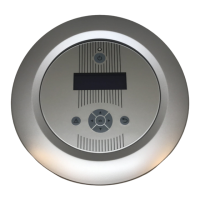Settings
6 720 645 172 (2010/07) en
22
In Own heat
curve
Own heat curve
Actual v.:
Set point:
Settings> Own heat curve
P:
I:
Deviation:
Pump:
Display
0°C
0
0
0 K
Off Winter, Summer, Off, On
E21
B Set the heat curve that shall apply for the unit in Set point curve.
B Set appropriate values for P and I.
B Set the temperature deviation that shall cause an alarm Accessory x temp. deviation
(Æ Chapter 5.6.51, page 36).
B Enter pump function. Winter means that the accessory circulation pump is in operation during winter
operation.
The unit uses an externally connected sensor to control a 0-10V connected mixing valve to maintain
the set point value according to settings in Set point curve.
In E11 heat
curve
E11 heat curve
Actual v.:
Offset:
Settings> E11 heat curve
P:
I:
Deviation:
Pump:
Display
0 K
0
0
0 K
Off Winter, Summer, Off, On
E21
B Set appropriate values for P and I.
B Set the temperature deviation that shall cause an alarm Accessory x temp. deviation
(Æ Chapter 5.6.51, page 36).
B Enter pump function. Winter means that the accessory circulation pump is in operation during winter
operation.
The unit uses an externally connected sensor to control a 0-10V connected mixing valve to maintain
the set point value according to the heat curve for E11.T1.
In Fixed sp
cooling
Fixed sp cooling
Actual v.:
Set point:
Settings> Fixed sp cooling
P:
I:
Deviation:
Pump:
Display
0°C
0
0
0 K
Off Winter, Summer, Off, On
E21
B Set the fixed set point value that must apply.
B Set appropriate values for P and I.
B Set the temperature deviation that shall cause an alarm Accessory x temp. deviation
(Æ Chapter 5.6.51, page 36).
B Enter pump function. Summer means that the accessory circulation pump is in operation during
summer operation.
The unit uses an externally connected sensor to control a 0-10V connected mixing valve to maintain
the stated fixed set point value.
Setting Factory Range HP
Tab. 37 Accessory

